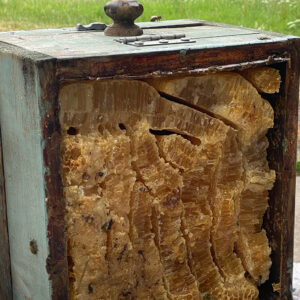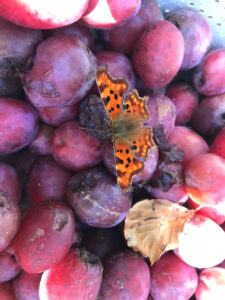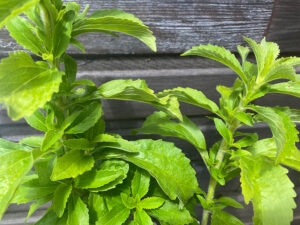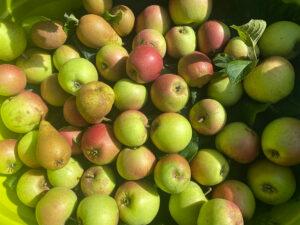
c. Jean Vernon
These days we are constantly told that sugar is bad for us, and yet it exists in nature and sustains many creatures, especially insects.
Now I’d be the first to admit I’ve got a bit of a sweet tooth, so when the sun ripened fruit is ready to pick, a fair amount never makes it into the kitchen. It’s like a living larder especially in the summer, a growing pick and mix that offers up all sorts of delightful sweet treats. And it’s not just the fruit either. Freshly podded peas, sweetcorn, pumpkin, ripe tomatoes and even carrots, beetroot and parsnips yield a fair amount of sweetness. Many plants convert starch into sugars which are stored in their cells, and this is what we taste when we eat them.
Personally, I’ve got a bit of a hatred of artificial sweeteners. I loathe the taste of them, so I prefer to choose natural sources of sweetness. My garden and greenhouse provides a virtual pick ‘n’ mix in terms of flavour and sweet treats.
Sweet lure

c. Jean Vernon
Plants produce nectar in their flowers to attract insects to feed there. It’s a mechanism that has evolved to facilitate fertilisation for the flower. The foraging insect sups nectar and moves from flower to flower, picking up pollen as they go and transferring it to other flowers. Nectar is rich in sugars. Honeybees collect it to make their winter food and their medicine; honey. Bumblebees collect it and store it in a wax pot as a rainy-day food store, other adult insects like butterflies, moths, flies, hoverflies, wasps and hornets feed on nectar to sustain their daily activity.
For the purest, sweetest natural sweetener honey is the ultimate choice. Regard it as a medicine and revere it. For the purest form choose honey from a natural beekeeper that doesn’t feed bees with sugar, doesn’t treat with chemicals and allows the bees to make their own wax and honeycomb.
Sweet nectar rich flowers

c. Jean Vernon
As a child one of my favourite tricks was to pick the flowers from white dead nettle and steal the nectar from the ends. As the plants resemble stinging nettles (only a bit) my peers weren’t too sure about this activity. And honestly, I can’t remember where I learned to do this.
I still steal plant nectar from time to time, but I tend to leave the lamium for the bees. One of my favourite plants to nectar rob these days is rosemary. The flowers themselves make a very subtle herbal tea, but each one has a pocket of nectar. Add a couple of leaves and the tea is naturally sweet, gently fragranced and really divine. But when your plant is in flower, gently pull the flower away from the plant and you will find a tiny drop of fragrant nectar at the end. You can even eat the whole flower or just chew the end where the nectar is. Always best if you don’t use chemicals in your garden when you try this.
Sweet leaf

c. Jean Vernon
A plant I was introduced to many moons ago, is known as sweet leaf. Botanically it is called Stevia rebaudiana. It is a natural sweetener and is used worldwide in a range of products from toothpaste to drinks and more. It’s 200 times sweeter than sugar and has ZERO calories. The fact that it can be fairly easily grown and was a natural alternative to some low-calorie commercial artificial sweeteners may have resulted in some rather curious and strict rules about growing this plant. The plant may be grown legally in most countries but there are some restrictions about its use. You can buy plants and seed in the UK but it is NOT approved for human consumption, but you can grow it as an ornamental herb. In case you are wondering; a tiny piece of leaf has an extraordinary sugary punch with a slightly bitter aftertaste.
Sweet Cicely is a good alternative with no restrictions on its use, but it comes with a warning – that it is essential to be absolutely sure of its identity before tasting, touching and using in your menus. It’s liquorice aftertaste is not to my liking so I avoid it, preferring other herbs like lavender mint and Moroccan mint as a sweeter flavour.
Fruit and fruit sugars

c. Jean Vernon
Leaving fruit to ripen in the sun, allows the natural sugars to develop, making garden grown fruit a fabulous source of sweetness, so much so you might find some sugar searching creatures feeding on overripe windfalls or harvests. I often find butterflies and wasps feeding on my Victoria plums. When ripe their honeyed sweetness is divine.
Fruit like apples develop their sweetness as they mature. Same for tomatoes, one of my favourite greenhouse treats. I can’t resist picking a sun blushed, ripe and warm fruit from the tomato vines and my absolute favourite is Honeycomb, which as the name suggests tastes almost as sweet as honey.
Pears are another source of rich sweetness; I love to pick them unripe and then allow them to ripen slowly in the greenhouse with my apples, until their inherent sugars are at their peak. Sweet, succulent pears are a fabulous addition to salads and cereals and can also be dried. But don’t forget grapes, another fruit rich in sugars that can be dried to make raisins concentrating their flavour and sweetness and preserving it for winter use.
Possibly the only fruit (and really, it’s a vegetable) that doesn’t exude as much sugary delight is the humble rhubarb, and yet it is a vital early pudding ingredient and its brutal acidity can be gently softened with a touch of baking powder.
So, if you’ve got a sweet tooth and are trying to avoid processed sugars and artificial sweeteners, take a closer look at what is growing in your greenhouse and garden and harvest some homegrown sweet treats. But be warned it can be addictive.


